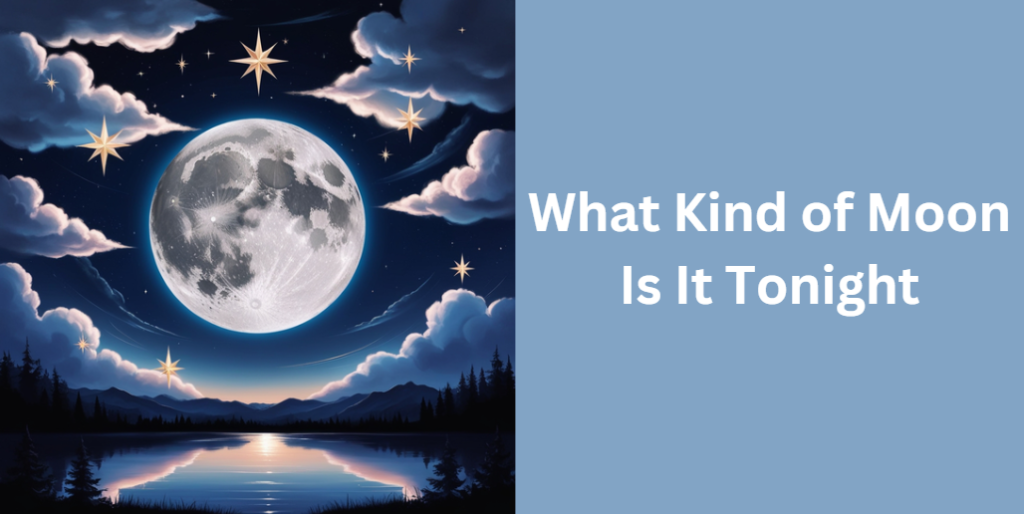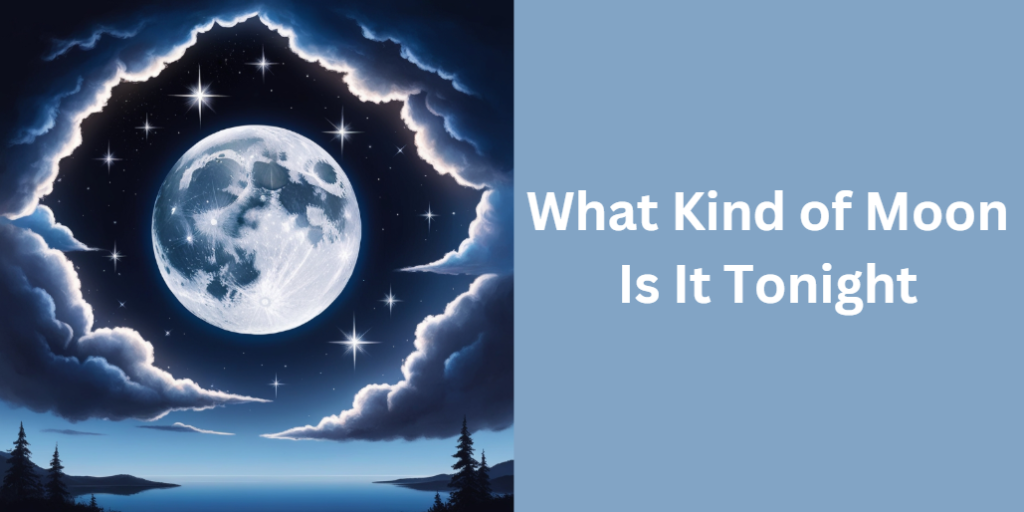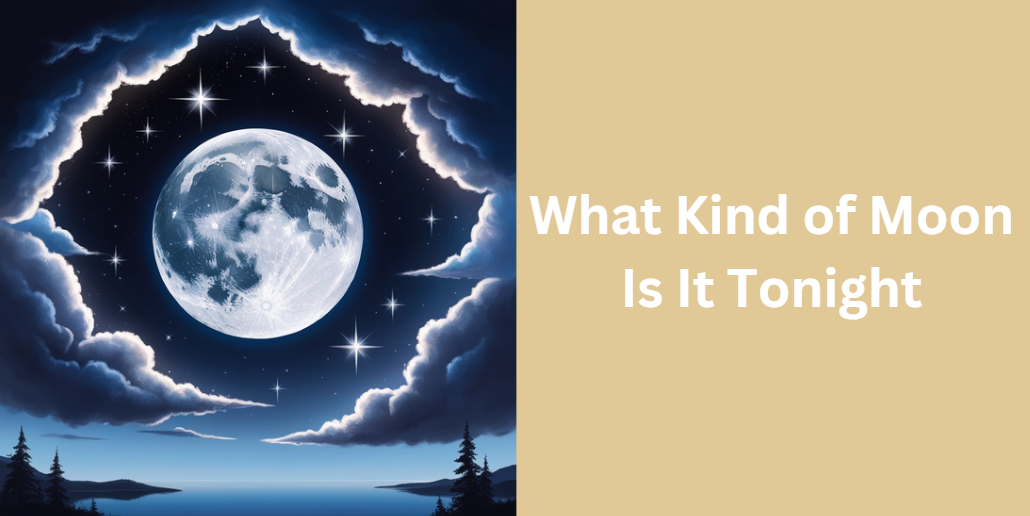Have you ever looked up at the night sky and wondered, “what kind of moon is it tonight?” The Moon goes through different phases every night, and understanding them can be fascinating. Whether you’re a stargazer, photographer, or just curious, knowing tonight’s Moon phase can help you plan your night better.
From New Moon to Full Moon, each phase has its significance. Some people believe the Moon influences human emotions and sleep cycles, while others track it for agricultural or spiritual reasons. In this guide, we’ll explore everything you need to know about tonight’s Moon, how to identify it, and what it means.
🌙 How to Identify Tonight’s Moon Phase?

If you want to know what kind of moon is it tonight, you can easily check by observing the sky or using online tools.
🔭 Steps to Identify Tonight’s Moon:
- Look at the Sky: Notice the shape and brightness of the Moon.
- Check the Time: Some phases, like the New Moon, may not be visible at night.
- Use a Moon Phase Calendar: Websites like NASA, Time and Date, or MoonGiant provide real-time Moon phase data.
- Download an Astronomy App: Apps like SkyView, Star Walk, or Moon Phase Tracker let you track the Moon in real time.
By following these steps, you can easily determine what kind of moon is it tonight without any technical knowledge!
🌕 The 8 Phases of the Moon Explained
The Moon follows a lunar cycle of approximately 29.5 days, during which it transitions through eight phases.
| Phase | Description | Visibility |
|---|---|---|
| 🌑 New Moon | Moon is not visible from Earth | Not visible |
| 🌒 Waxing Crescent | A small crescent appears on the right side | Just after sunset |
| 🌓 First Quarter | Half of the Moon is illuminated | Evening sky |
| 🌔 Waxing Gibbous | More than half is visible but not yet full | Evening & night |
| 🌕 Full Moon | The entire Moon is bright & fully visible | All night |
| 🌖 Waning Gibbous | Slowly shrinking after Full Moon | Late night & early morning |
| 🌗 Last Quarter | The left half of the Moon is visible | Early morning |
| 🌘 Waning Crescent | Only a thin crescent remains on the left | Just before sunrise |
Each phase has unique characteristics, and knowing them can help you appreciate the beauty of the Moon’s journey across the night sky.
🌍 Tonight’s Moon vs. Yesterday & Tomorrow: What’s Different?

The Moon changes slightly every night, which is why tonight’s Moon will look different from yesterday’s and tomorrow’s.
- Last Night: The Moon was one step behind in its phase compared to today.
- Tonight: We are seeing the current phase at its best visibility.
- Tomorrow: The Moon will continue its natural transition towards the next phase.
By following a lunar calendar, you can predict the upcoming Moon phases and plan special skywatching events.
🔬 The Science Behind the Moon’s Phases
Many people wonder why the Moon changes shape every night. The answer lies in the Moon’s orbit around Earth and how sunlight reflects off its surface.
- The Moon orbits Earth in 27.3 days.
- The Earth also moves, causing the 29.5-day lunar cycle.
- We see different portions of the Moon lit by the Sun, leading to changing phases.
This cycle repeats every month, influencing tides, weather, and even biological cycles.
🌊 How the Moon Affects Nature & Human Life
The Moon doesn’t just light up the night sky—it has powerful effects on Earth and life.
🌊 1. The Moon & Ocean Tides
The Moon’s gravitational pull controls ocean tides. During Full Moons & New Moons, tides are stronger, affecting marine life and fishing conditions.
🌱 2. The Moon & Plant Growth
Many farmers use lunar cycles to plant and harvest crops. Some believe that planting during a Waxing Moon leads to stronger plant growth.
💤 3. The Moon & Sleep
Studies suggest that during a Full Moon, people sleep less and have lighter sleep cycles. This is due to increased brightness and possibly biological influences.
🧠 4. The Moon & Human Behavior
Some believe that the Moon affects emotions and mental health, but science remains inconclusive. However, emergency rooms and crime rates are said to spike during Full Moons!
📅 Special Moons & Rare Lunar Events

Certain special Moons occur throughout the year. These include:
- 🌕 Supermoons: When the Moon is closest to Earth, appearing extra bright.
- 🌕 Blue Moons: The second Full Moon in a calendar month.
- 🌕 Blood Moons: A total lunar eclipse where the Moon turns red.
- 🌕 Harvest Moons: The Full Moon closest to the Fall Equinox.
These unique lunar events make tonight’s Moon even more exciting for skywatchers!
📷 How to Observe & Photograph Tonight’s Moon
If you’re a skywatcher or photographer, capturing the Moon can be rewarding.
🛠 Tips for Observing the Moon:
- Find a dark location away from city lights.
- Use binoculars or a telescope for better details.
- Check weather conditions for clear skies.
📸 How to Take Stunning Moon Photos:
- Use a tripod for stability.
- Adjust ISO & shutter speed to avoid overexposure.
- Try a zoom lens for detailed close-ups.
With the right tools, you can capture the beauty of the Moon like a professional!
🔎 FAQs: Answering Common Moon Questions
1️⃣ Q: Why does the Moon sometimes appear upside down in different parts of the world?
A: The Moon’s appearance changes depending on where you are on Earth. In the Northern Hemisphere, the Moon’s illuminated part grows from right to left. In the Southern Hemisphere, it appears to grow from left to right. This is because people in different hemispheres are viewing the Moon from opposite perspectives.
2️⃣ Q: Does the Moon have its own light, or does it reflect sunlight?
A: The Moon does not produce its own light. Instead, it reflects sunlight. The amount of light we see depends on the Moon’s position relative to the Earth and Sun, which is why we see different phases throughout the month.
3️⃣ Q: Can the Moon affect weather patterns on Earth?
A: While the Moon significantly influences ocean tides, its effect on the weather is minimal. Some studies suggest that during Full Moons, there might be slightly higher temperatures and more cloud cover, but these effects are small compared to other weather factors like wind and air pressure.
4️⃣ Q: Why do astronauts experience lower gravity on the Moon than on Earth?
A: The Moon’s gravity is only 1/6th of Earth’s gravity because it has less mass than Earth. This is why astronauts can jump higher and move differently on the Moon’s surface compared to how they move on Earth.
5️⃣ Q: How does the Moon affect animal behavior?
A: Many animals, especially nocturnal species, adjust their activities based on the Moon. For example:
- Coral reefs time their spawning with the Full Moon.
- Lions hunt more actively in darker Moon phases.
- Sea turtles lay eggs under the cover of a dark night to avoid predators.
Scientists continue to study the Moon’s impact on animal behaviors and how they have evolved with lunar cycles.
🌟 Conclusion: What’s Next for the Moon?
So, what kind of moon is it tonight? Now you know how to identify tonight’s Moon phase, its meaning, and how it affects the world around us. Whether you’re a casual observer or a serious astronomer, tracking the Moon can be a fun and rewarding experience.
Want to stay updated on upcoming Full Moons and eclipses? Bookmark this page and keep looking up at the night sky! 🌙✨
Affiliated Posts Like What Kind of Moon Is It Tonight
JLDQ.19B.306.149D01 – The Ultimate Recliner Actuator Guide
Botox Shampoo Bestes Produkt Heklong – The Ultimate Guide for Healthier Hair
Comprehensive Guide to 09732370961 Partita IVA: Moto Service di Miraglia Davide


